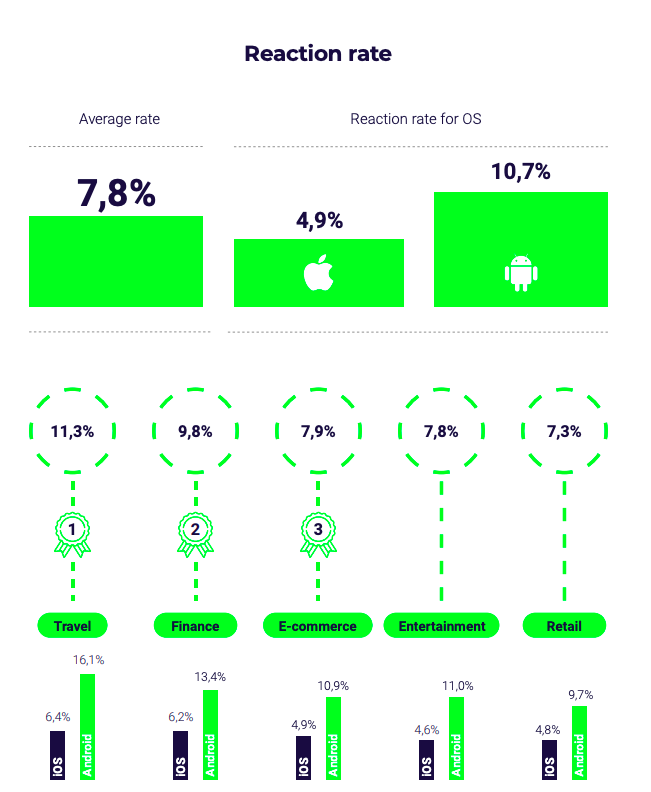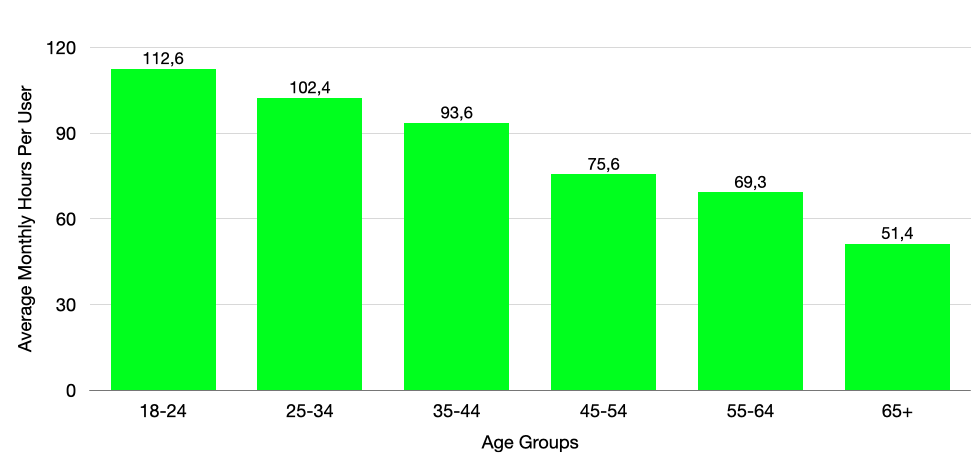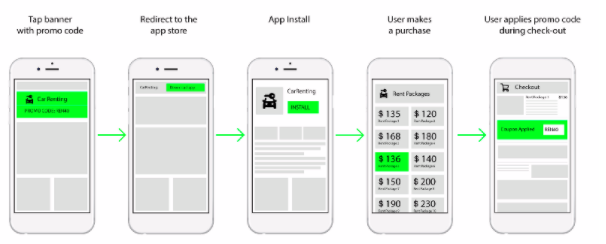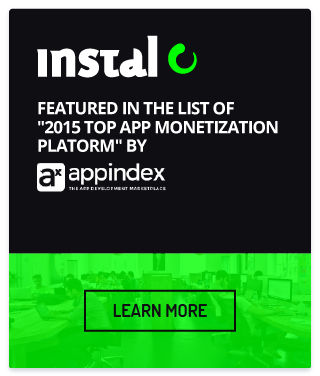How To Re-engage Inactive Users
Today, users spend between 4 – 5 hours per day (on average) on their mobile devices. Even though the average person has 40 apps installed on the phone, 89% of the time is split between 18 apps. This means, more than half of those apps remain unused. Stats also underline with the increase in the age group, the number of apps installed decreases. People between the ages of 18-24 spend, on average, more than 112 hours using apps, while people older than 65 only 51 hours.
There are several techniques to re-engage inactive users, but pay attention: re-engagement is not a cure-all technique though. Marketers need to keep in mind that an effective re-engagement campaign needs to be carried out when they see early signs of decreasing engagement, instead of waiting until users uninstall their apps.
Some main re-engagement techniques are comprised of re-targeting, incentives and rewards, push notifications, email, and deep linking:
- Retargeting: ads are served to target specific users who’ve previously visited or interacted with the app, but haven’t completed a particular action (i.e. purchase).
- Incentives and rewards: drive conversions by sending out specific incentives or/and rewards specifically for mobile (coupons, promotional offers).
- Push notifications: notifications on a user’s screen to notify them about new offers, events, or messages when the user has not actively engaged with the app for a set period.
- Email: messages allowing precise targeting and better engagement, designed to bring back inactive subscribers.
- Deep linking: an effective way to link specific pages within the app, taking users to a particular profile page.
Retargeting
Retargeting (also known as remarketing) is a form of direct advertising where users are targeted on the basis of their previous actions. Usually, it addresses users who have already shown interest in a product or downloaded an app but failed in completing a well-defined action (i.e make a purchase, opening the app x times). Retargeting tries to capture their interest again by serving specific offers and promotions in order to entice them back in the app or persuade them to complete an action.
For mobile, retargeting can be a useful tool to establish a one on one interaction between brands and users in order to bring them down the very end of the conversion funnel. Typically, when users download an app without being redirected to the app store by an advertising message, they are labeled as organic users. Once they start using the app, they become active users. If they are not using the app for a specific amount of time, advertisers can decide to retarget these high-valued users. Depending on the goal of the campaigns, two different types of retargeting can be set up: static and dynamic.
Static retargeting: a static retargeting campaign creates the same static ad and serves it to a standardized audience base. In this case, a CSV file, containing a list of user IDs, is uploaded on the retargeting platform. Afterward, the list is divided into several subgroups based on age, gender, and location. Specific conditions are set for the campaign. All the people within a specific group will be targeted and see a certain message.
Static retargeting is applicable when:
- the goal is to generate leads or inform the audience
- the goal is to improve brand awareness
- the target involves different types of customers but not individual ones
- the goal is to promote a single or specific product
Dynamic retargeting: a dynamic retargeting campaign creates personalized ads for each user. Through machine learning technology, past behaviors and preferences of users are analyzed to identify which creativities can persuade them to actively engage with an app again and to hopefully complete a well-defined action. Dynamic retargeting can be at an audience or creative level. How users are moving along the conversion funnel (open, add to chart, etc) is something to be considered when it comes to this – or it can be customized depending on past behaviors within the app.
Dynamic retargeting is particularly suitable when:
- the company is an eCommerce one
- the target is a broad audience base
- the goal is to promote several products and test customers’ preferences
Incentives and rewards
Another technique marketers can rely on to re-engage their inactive users is setting incentives and rewards to drive conversions and increase customer engagement. Incentives and rewards can include coupons, personalized offers, and discounts. Gamification, defined as the application of game-design elements and game principles in non-game contexts, is a key strategy often used to get users hooked on an app. This results in driving them down the conversion funnel to re-engage dormant users and acquire new ones.
Push notifications
Push notifications are another useful tool marketers can use to re-engage their inactive users. Push notifications are messages that pop up on users’ screens to notify them about new offers, events, or messages when the user has not actively engaged with the app for a set period.
According to recent studies, the average worldwide push notification opt-in rate (meaning the number of people who’ve accepted to receive push notifications) is 67.5%. If broken down by OS, then: 43.9% for iOS and 91.1% for Android. Verticals like finance, travel, e-commerce, and entertainment show some of the highest opt-in rates.
 The average worldwide click rate of push notifications is 7.8% (iOS = 4.9% and Android = 10.7%). The top 5 app sectors with the highest reaction rates are travel (11.3%), finance (9.8%), e-commerce (7.9%), entertainment (7.8%) and retail (7.3%).
The average worldwide click rate of push notifications is 7.8% (iOS = 4.9% and Android = 10.7%). The top 5 app sectors with the highest reaction rates are travel (11.3%), finance (9.8%), e-commerce (7.9%), entertainment (7.8%) and retail (7.3%).
The same studies also revealed the average click rate of 21.9% for in-app messages (messages displayed within the application while in use). Alert boxes, standard banners, and interstitial are the best performing ad formats in terms of click rates.
To get the most out of re-engagement campaigns, marketers need to keep in mind some basic key features when dealing with push notifications:
- Personalization and relevant content to capture the attention of users in order to increase engagement
- A/B testing to understand what content people are engaging with
- Appropriate timing to identify when users are more likely to open the message
- Deep links which lead to the right content within the app (increasing the likelihood of conversion).
Today more than 70% of people receive emails on their mobile devices, which makes emails an effective way to re-engage dormant customers since they can be used to push and deliver tailored messages.
Although there isn’t one standard strategy (it varies) on how to craft effective email marketing campaigns, there are some tips:
- Perform A/B testing with content and email subjects to understand how people are reacting
- Keep it short and get straight to the point
- Place a clear and high-impacting call-to-action in your email to increase the likelihood of getting what you’re looking for
- Segment your audience to ensure that you only target users you have to re-engage and to deliver relevant content.
Deep Linking
Deep Linking is defined as the ability to link directly to a specific page within a native iOS or Android mobile app rather than just launching it. Deep Linking comes in different sizes and formats. It can be considered a useful and flexible solution to improve app marketing strategies with its crucial goal being retention. Deep Linking is all about advanced retargeting. By setting up specific parameters — users can be redirected anywhere within the app. This includes offer pages, product lists, or items they’ve searched for before. This helps to construct a personalized and unique experience, which results in improved engagement and retention rates (along with increased marketing revenue and ROI).
Deep Linking can be essential for the re-engagement of inactive users, and this is where incentivization comes into play. When users install an app but are not engaging with it, marketers can utilize deep links to redirect them to specific content or app pages to encourage the revival of app usage (instead of an ordinary welcome page). It’s all about the ability to re-target people in order to bring them back into the app – whether through the appeal of something new or promoting exclusive deals or features. The end goal is to link these incentives with re-engagement.
Wrapping up
Re-engaging users requires a lot of effort and strategizing – it involves an in-depth analysis of user preference and behavior in order to deliver relevant content at the right time and place. Combining highly precise targeting, moment-specific campaigns, and dynamic, impacting creativities are the essential factors that mark a successful re-engagement campaign. We developed our own re-engagement solution which helps support app marketers through all phases of the customer journey in their campaign strategy. By using AI technology and dynamic creatives, we provide advertisers with behavior and user-specific product. This engages users and boosts in-app conversions. Depending on customer behavior, we re-engage them with custom messages and creativities, which maximizes their LTV. Our ML and AI algorithms scan and collect information about user actions and preferences to predict how they will behave, This allows for the definition of customized re-engagement campaigns.




